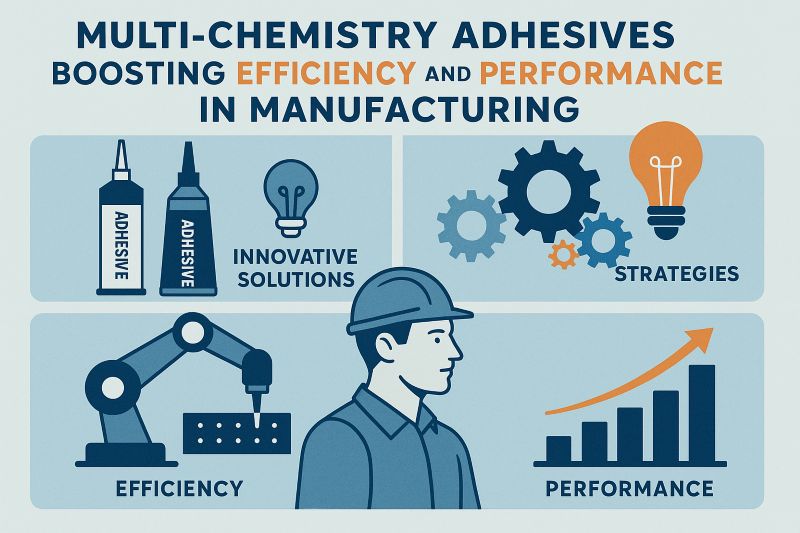
Efficiency in Adhesive Solutions
Defining Multi-Chemistry Adhesives
Types of Adhesive Solutions
Strategies for Maximizing Efficiency
Importance of Multi-Chemistry Adhesives
Latest Trends in Adhesive Technologies
Methods to Enhance Adhesive Performance
Frequently Asked Questions (FAQ)
In today's fast-paced manufacturing environment, efficiency is critical. Multi-chemistry adhesive solutions, which combine different adhesive technologies into one formulation, enable manufacturers to reduce the number of products required while achieving high performance. These solutions streamline operations, shorten production cycles, and simplify inventory by providing reliable bonding across diverse substrates and conditions.
Multi-chemistry adhesives are formulations that incorporate multiple adhesive chemistries—such as epoxy, polyurethane, acrylic, or silicone—to deliver superior versatility and performance. This integration enables the adhesive to exhibit characteristics like high strength, elasticity, quick curing, or chemical resistance within a single solution. The result is reduced process complexity and broader application compatibility, enhancing overall manufacturing efficiency.
Adhesives are broadly categorized by their chemical structure and curing mechanisms. Common types include:
Epoxies: Known for their high mechanical strength and chemical resistance, often used in structural bonding.
Acrylics: Fast-curing and resistant to environmental exposure, suitable for dynamic environments.
Cyanoacrylates: Offer rapid bonding, ideal for small-scale or emergency repairs.
Polyurethanes: Provide excellent flexibility and impact resistance for substrates exposed to movement or vibration.
Multi-chemistry adhesives may combine two or more of these types to achieve multifunctionality in a single product.
To maximize the benefits of multi-chemistry adhesives, businesses can implement several strategies:
Application Matching: Select adhesives based on specific performance needs—e.g., high stress, thermal exposure, or sealing.
Inventory Simplification: Use multi-functional adhesives to replace several single-purpose ones.
Cross-Process Integration: Choose adhesives that work across multiple stages or components in the production line.
Automation Compatibility: Opt for adhesives designed for use with modern application methods like automated dispensing or roll-coating.
The growing demand for streamlined operations, reduced waste, and adaptable materials has made multi-chemistry adhesives increasingly important. These advanced solutions help manufacturers:
Reduce changeovers and downtime
Lower adhesive consumption through targeted performance
Improve bonding reliability across various substrates
Align with sustainability goals by minimizing excess usage
Their versatility directly supports lean manufacturing practices and robust quality control.
Current trends in adhesive development focus on multi-functionality and performance optimization. Key innovations include:
Hybrid formulations that combine structural strength with environmental flexibility
Fast-curing systems compatible with high-speed production
Eco-conscious designs utilizing renewable or low-emission components
Customization for automated systems, improving consistency and reducing operator error
These trends reflect a broader push toward cost efficiency, sustainability, and adaptability in industrial operations.
Adhesive performance can be improved through the following methods:
Surface Preparation: Ensure clean, dry, and properly treated substrates to enhance adhesion.
Environmental Matching: Select adhesives designed for specific temperature, moisture, or chemical exposures.
Curing Optimization: Use correct curing times and temperatures for optimal bond strength.
Application Precision: Employ tools or automated systems that ensure accurate and consistent adhesive application.
These practices not only enhance bond integrity but also support faster throughput and reduced rework.
Q: What are multi-chemistry adhesives?
A: They are adhesive formulations that combine two or more chemical technologies—such as epoxy, polyurethane, or silicone—into a single product for enhanced performance and versatility.
Q: How do multi-chemistry adhesives improve efficiency?
A: They reduce the number of adhesives needed, simplify procurement, decrease downtime, and enable more consistent application across different production needs.
Q: What types of adhesive solutions exist?
A: Common types include epoxies, acrylics, cyanoacrylates, and polyurethanes, each offering distinct benefits in bonding strength, speed, flexibility, or resistance.
Q: What are examples of multi-chemistry advantages?
A: They offer combined benefits like high strength with flexibility, or fast curing with long-term durability, suitable for multiple applications without switching products.
Q: How can efficiency be maximized using adhesives?
A: By choosing the right adhesive for each task, optimizing surface preparation, and integrating solutions into automated workflows, manufacturers can boost productivity.
Q: Why are these adhesives valuable in industrial settings?
A: Their versatility reduces material waste, inventory load, and processing time, all while ensuring high-performance bonding under varying conditions.
Q: What are the current trends in adhesive technology?
A: Industry trends focus on hybrid formulations, faster curing cycles, sustainability, and compatibility with advanced manufacturing technologies.
Q: How do I enhance adhesive performance?
A: Key methods include thorough surface cleaning, using appropriate curing techniques, and matching adhesive types to specific operational environments.